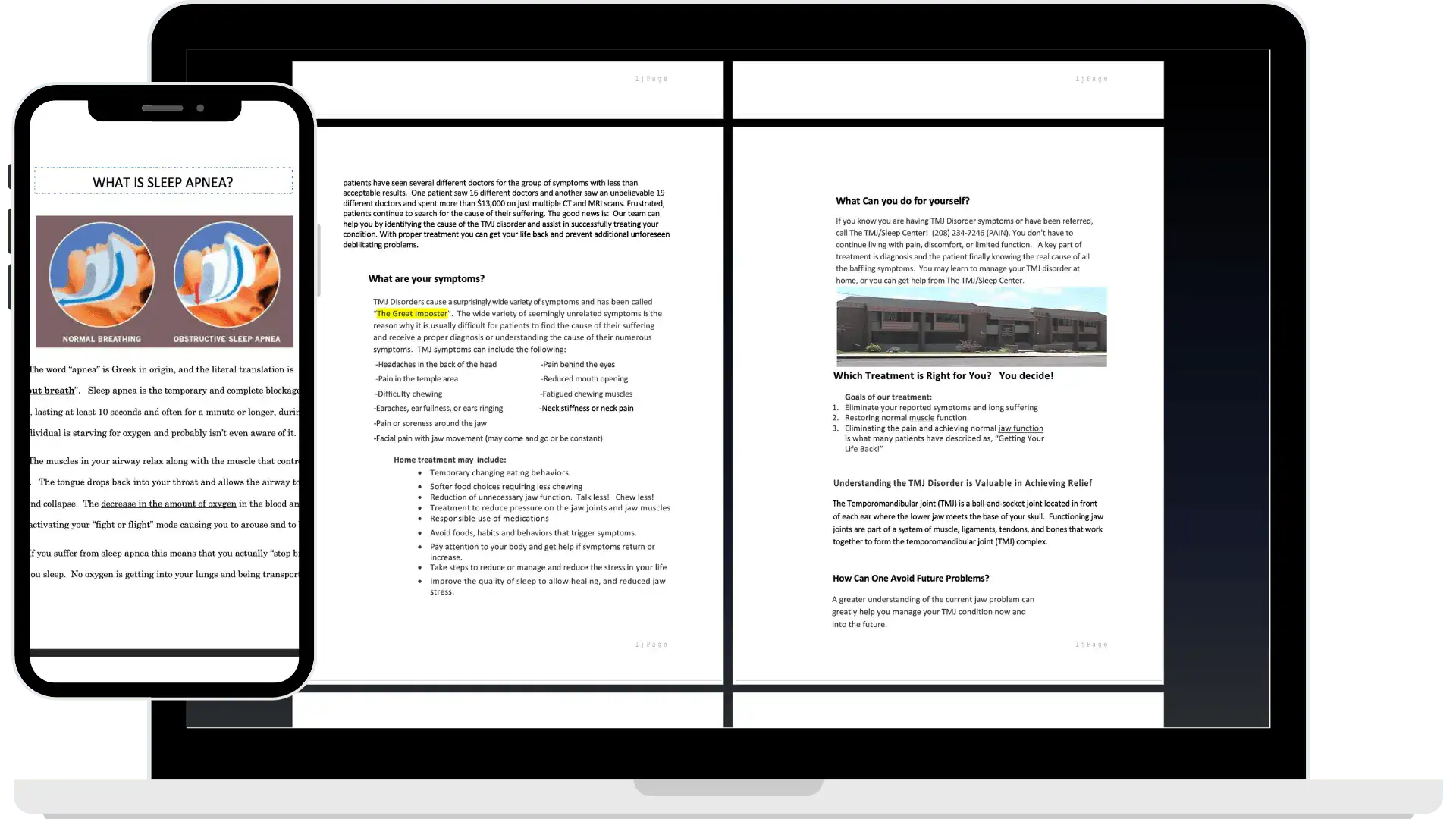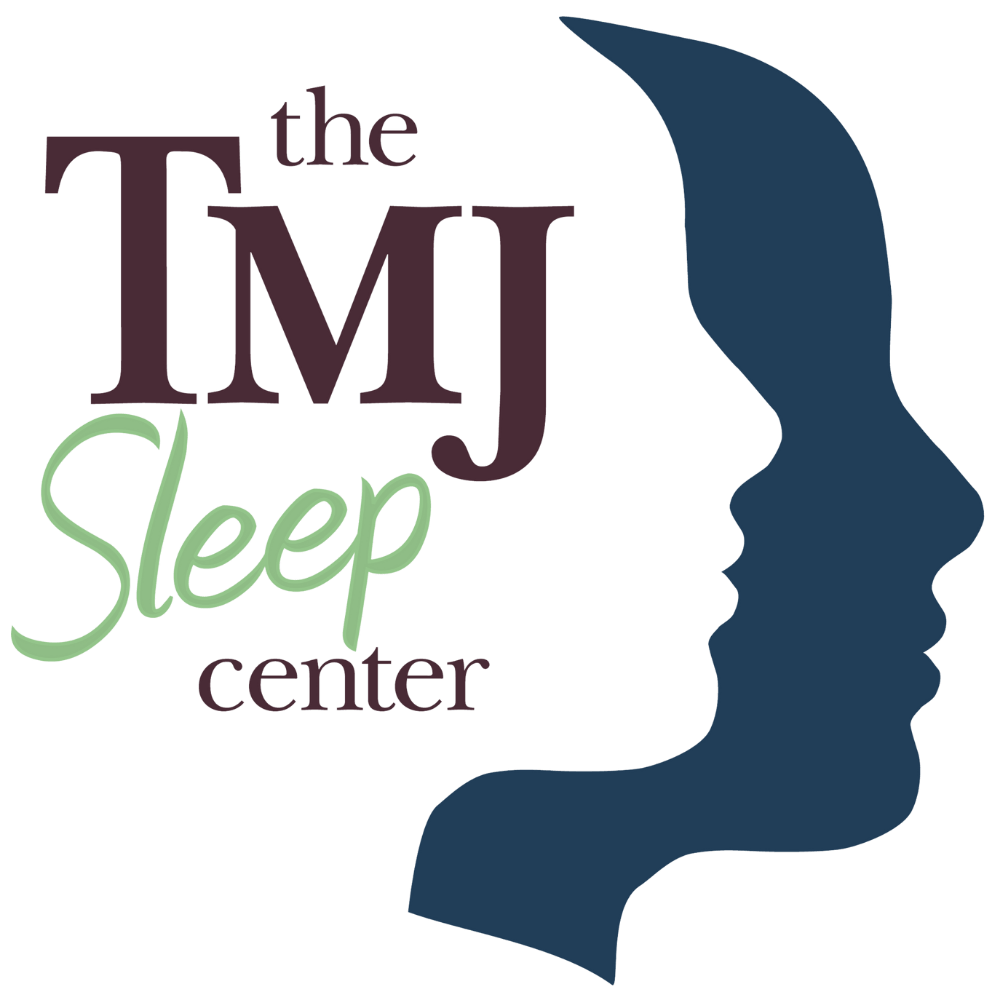TMJ Examinations
TMJ Disorders Are More Than Joint Pain
According to the National Institute of Dental and Craniofacial Research, temporomandibular joint (TMJ) issues affect more than 12% of individuals in the United States. Our trained doctor with more than 30 years experience and staff with more than 40 years’ combined experience having treated more than 4,000 patients at The TMJ Sleep Center and understand TMJ conditions are much more than simply jaw discomfort.
TMJ disorders can frequently cause debilitating headaches, ear pain, ear pressure, ringing in the ears, eye pain, sinus pain, facial pain, jaw joint cracking, and even neck pain that interfere with daily activities and can take control of one’s life. Our experienced and caring staff provide answers to your questions, with effective treatment, and will assist you as you get your life back.
Call for a complimentary consultation appointment or visit us today. Be sure to download your copy of Dr. Romriell’s TMJ Patient Consumer Guide.
Enjoy our fresh-baked cookies!
Physical Examination
We will initially examine your face, neck, and jaw muscles routinely over the course of your treatment for a TMJ disorder. Examinations we conduct include pressing (palpating) the muscles and jaw joints and evaluating and measuring how you move your jaw and how the jaw functions.
Dr. Romriell will examine the jaw joint and muscles for pain, tension, and tenderness. In most cases, a range of mandibular motion measurements and CAT scan imaging will be a vital part of your initial exam and regular follow-up checks.
Range of Motion of the Jaw
TMJ disorders (TMDs) usually limit your jaw movement. Normal jaw opening is 50 mm and the jaw should move 15 mm left and 15 mm right without causing any pain. Your range of jaw motion in opening and moving to the left and right will be measured at every appointment throughout your TMJ treatment. Typically, the mandibular range of motion will increase substantially during the initial examination, and the appropriate treatment will maintain the jaw movement and, in most cases, the movement will continue to improve during treatment. No more $ dollar burgers!
Imaging Tests
We use advanced, highly accurate equipment and techniques in formulating a diagnosis.
CT-Scan
CT images are taken in our office and Dr. Romriell will pinpoint any concerns – including bone-on-bone contact, fractures, dislocations, and bone degeneration within the jaw joint. You can even take a copy of your CT images home with you!
Tooth Impressions
We take an imprint of your teeth and record your bite to give us an exact replica of your teeth and your bite position. This will give our doctors a very accurate model to evaluate your bite and construct the necessary TMJ treatment appliances designed to improve jaw movement.
BBB (Ball Bearing Bite Recorder)
BBBs are professionally known as Gothic arch tracers. BBB is much simpler.
The ball-bearing-bite recorder is a two-piece appliance which is constructed to fit models of your teeth. The BBBs fit over the top and bottom teeth and allow us to very accurately record your treatment bite position. We regularly use this technology for recording your bite and constructing more precise dental appliances in a more healthy position. As the muscles and jaw joint repair the jaw position is expected to change.
Neuromuscular Examination
We assess your jaw joint to determine if there are any imbalances using computerized range-of-motion (EGN) and T-Scan recording methods. The examination is a non-invasive procedure that combines the whole-body approach and state-of-the-art ultrasound, EMG, JVA, EGN, T-Scan, and trigger point examination.
EMG – Electromyography
The muscles exhibit the primary symptoms of TMJ disorder. EMG is a method used to evaluate the signal to the muscle and the ability of the muscles to contract. The EMG will actively measure the resting activity as well as the muscle activity when fully contracted. The EMG recording will determine if the appropriate muscles are working together at the appropriate time. When the doctor adjusts and improves the jaw joint position, it will immediately facilitate the improvement In muscle contraction and the capacity of the muscle to rest. As the muscle begins to rest, the pain quickly goes away!
JVA – Joint Vibration Analysis
Joint vibration analysis is a tool used to identify the presence of bone-upon-bone contact within the jaw joint during jaw movement. It helps us identify cases that need jaw surgery. The possibility of bone-upon-bone rubbing and wear is obviously not a good thing, and we would like to know if that condition exists prior to initiating any conservative TMJ treatment.
EGN – Electrognathography
EGN is a computerized method of recording to review the movements of the jaw. TMJ patients usually have jaw joint problems and tight, sore chewing muscles, both of which have an effect upon the way the jaw moves. The jaw will deflect toward the tightest jaw muscles and toward the side of the joint that is the most restricted in its ability to move.
T-Scan
The T-Scan provides a computerized, dynamic recording of tooth contact as you bite down and chew. We record your pretreatment bite condition showing which tooth touches 1st, 2nd, 3rd, 4th, and so on until the teeth are all closed completely. Normally, all of the back teeth touch together at the same time with half of the biting force on the left and the other 50% of force on the right side.
The T-Scan records the amount of force on each tooth and the balance of force, front to back and left to right. This recording is made at least twice during treatment, including the beginning bite position, and the recording of the bite or tooth contact at maximum TMJ improvement. The T-Scan is utilized when communicating with the referring medical doctor or dentist. It is also used when shaping and contouring the teeth is necessary to achieve a balanced bite.
Magnetic Resonance Imaging (MRI)
MRI produces images of soft tissue, muscles, discs, and ligaments of the jaw and head. We may prescribe and send you out to have an MRI taken when there is a need for surgical treatment of the jaw joint. With the help of an MRI, we are able to look at the position and condition of the disc in the jaw joint, jaw joint position in the fossa, jaw, and disc dislocations, joint degeneration, and fractures.
Reviews
Related TMJ Services

Learn More About
The TMJ Sleep Center
Located at 1777 E Clark St, Pocatello, ID, We specialize in the treatment of TMJ disorders, migraine headaches, and sleep apnea treatments. Work with all insurance. Complimentary consultations. Walk-ins welcome. Call today for an appointment or visit us.


Share On: